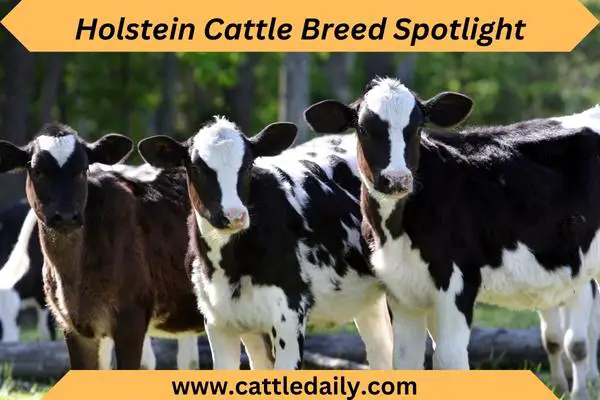Holstein Cattle Breed Spotlight
The Holstein is one of the most popular and widely recognized cattle breeds in the world. With their distinct black and white markings, high milk production, and well-suited temperament, Holsteins have become the breed of choice for many dairy farmers across the globe.
Origin and History
The Holstein breed originated in the Netherlands over 2,000 years ago. Their original homeland was in the northern Dutch provinces of North Holland and Friesland as well as Schleswig-Holstein in Germany.
These cattle were bred to adapt and thrive in the cool maritime climate and convert the abundant grass into milk. Over centuries of selective breeding, the breed became higher-producing and more refined.
Holsteins were first imported to the United States in the late 1800s and gained tremendous popularity due to their outstanding milk production. Today, Holsteins make up over 90% of the dairy cattle population in the US and are present in 128 countries worldwide.
Distinctive Characteristics
Holsteins are most easily recognized by their signature black and white markings. Their black parts range from almost 90% to 20%, with the ideal being a 50-50 balance between black and white. This striking color pattern is a result of artificial selection by breeders.
Other typical features include:
- Large framed body with a straight, broad back
- Wedge-shaped head with a broad muzzle
- Black nose and tongue
- Black hooves
- Udder with all four quarters of equal size
Mature Holstein cows weigh around 1500 pounds and stand around 59 inches tall at the shoulder. Bulls are larger, weighing up to 2200 pounds.

Milk Production
The Holstein breed holds the title of the highest milk-producing dairy cattle in the world. Top producers in optimal conditions can give over 30,000 pounds of milk per lactation.
The average Holstein in the United States produces around 23,000 pounds annually. Careful genetic selection has increased both the quantity and quality of their milk over the past century.
Holsteins thrive on specialized feeding programs tailored to support their high milk yields. These include high-energy rations with supplemental concentrates and optimized nutrition.
Their milk contains on average 3.6% butterfat and 3.1% protein. Holsteins are considered a dual-purpose breed, raised for both abundant milk and lean beef production.
Temperament
Holsteins are well known for their mellow, docile temperaments. They tend to be tolerant of intensive management and close human handling required in dairy operations.
As herd-loving animals, Holsteins interact amiably with each other and their caretakers. They readily adapt to different housing systems and can be kept in groups in free-stall barns.
Their calm nature and easygoing disposition make them an excellent choice for small family dairy farms. Overall, Holsteins have a pleasant temperament suited for modern commercial dairying.
Common Health Issues
Due to their large size and incredible milk output, Holsteins can be prone to certain health problems, including:
- Mastitis – inflammation of the mammary gland, often caused by bacteria
- Milk fever – low blood calcium after calving due to demands of lactation
- Laminitis – inflammation and swelling of tissues in the hooves
- Reproductive issues – infertility, weak calves, reduced fertility
Proper preventative care and early treatment can prevent many problems. Overall, Holsteins are a robust breed with good hardiness when properly managed. Their general health and longevity have improved greatly over the years through genetic selection.

Adaptability
Holsteins are highly adaptable cattle. Originally bred in the temperate climates of northern Europe, they can now be found thriving in over 128 countries worldwide, on 6 continents.
They perform well across a wide range of management systems, from pasture-based to total confinement operations. Holsteins can be productive on just forage and grazing or on intensive high-grain diets.
Their versatility enables them to succeed in diverse environments. Hot or cold, arid or humid, Holsteins can adapt through selective breeding for fitness traits that suit local conditions.
Overall, the Holstein breed has demonstrated outstanding adaptability worldwide. Their flexibility and wide environmental tolerance is a key reasons for the Holstein’s enormous popularity across the globe.
Popularity and Use
Holsteins are the most popular dairy cattle breed in commercial use worldwide. They can be found on farms of all sizes, from large dairy operations with thousands of cows to small family farms with just a few heads.
As the highest-production dairy animals, Holsteins are well suited to meet the demands of the dairy industry and produce large volumes of milk. Their efficient conversion of feed to milk has led to their widespread use globally.
While Holsteins are raised predominantly for the dairy industry, they are also used for beef production. Holstein steers grow quickly and produce high-quality lean beef. The white and black Holsteins are instantly recognizable as the iconic dairy cow.
Future Outlook
With global demand for dairy products continuing to rise, especially in developing countries, the efficient high-production Holstein will have an integral role in meeting these needs.
Genomic selection and reproductive technologies can further increase milk yields and improve fitness traits. As the premier dairy cattle breed for over a century, the dominance of the Holstein looks set to continue long into the future.
So in summary, with their high milk production, iconic black-and-white appearance, calm temperament, and worldwide popularity, Holsteins have firmly cemented their place as the number one dairy cattle breed.
They will continue making valuable contributions to the dairy industry for generations to come. Learn here more about cattle breeds types and tips.


